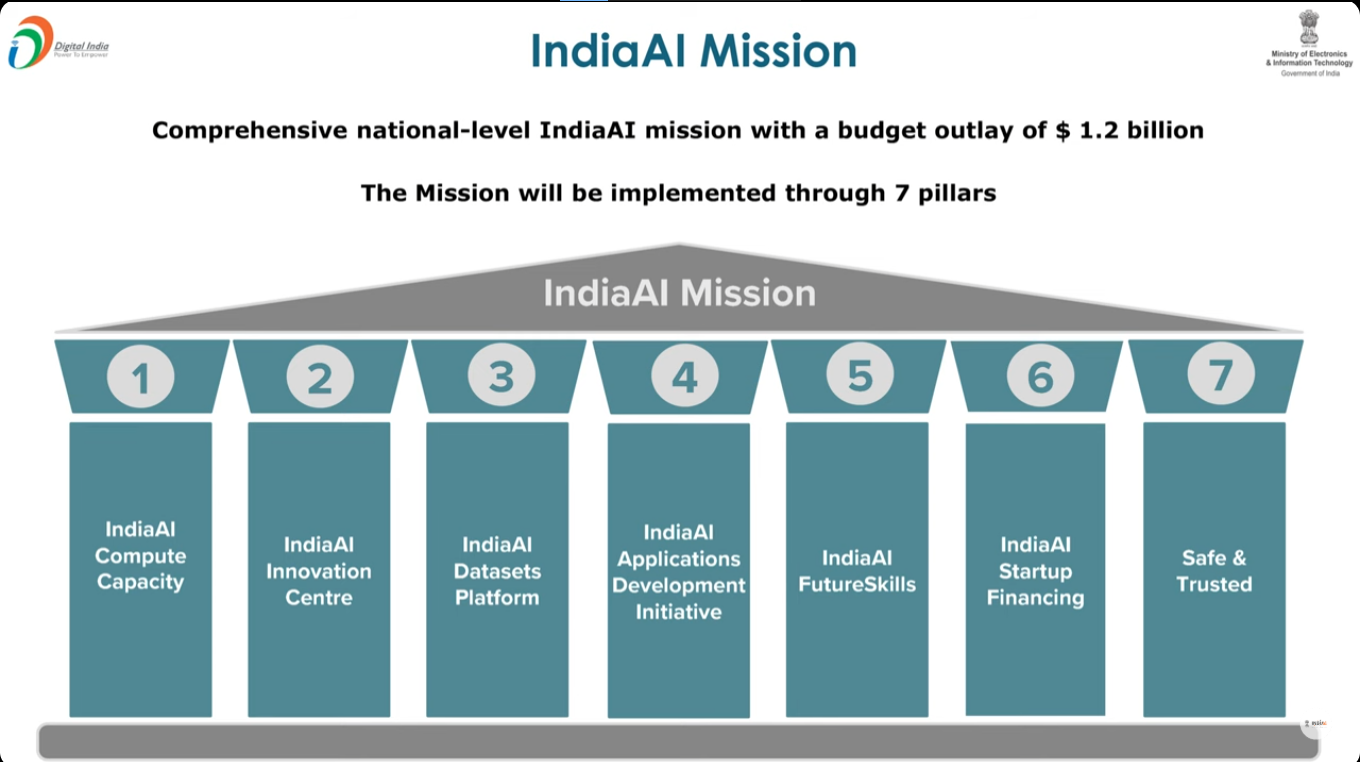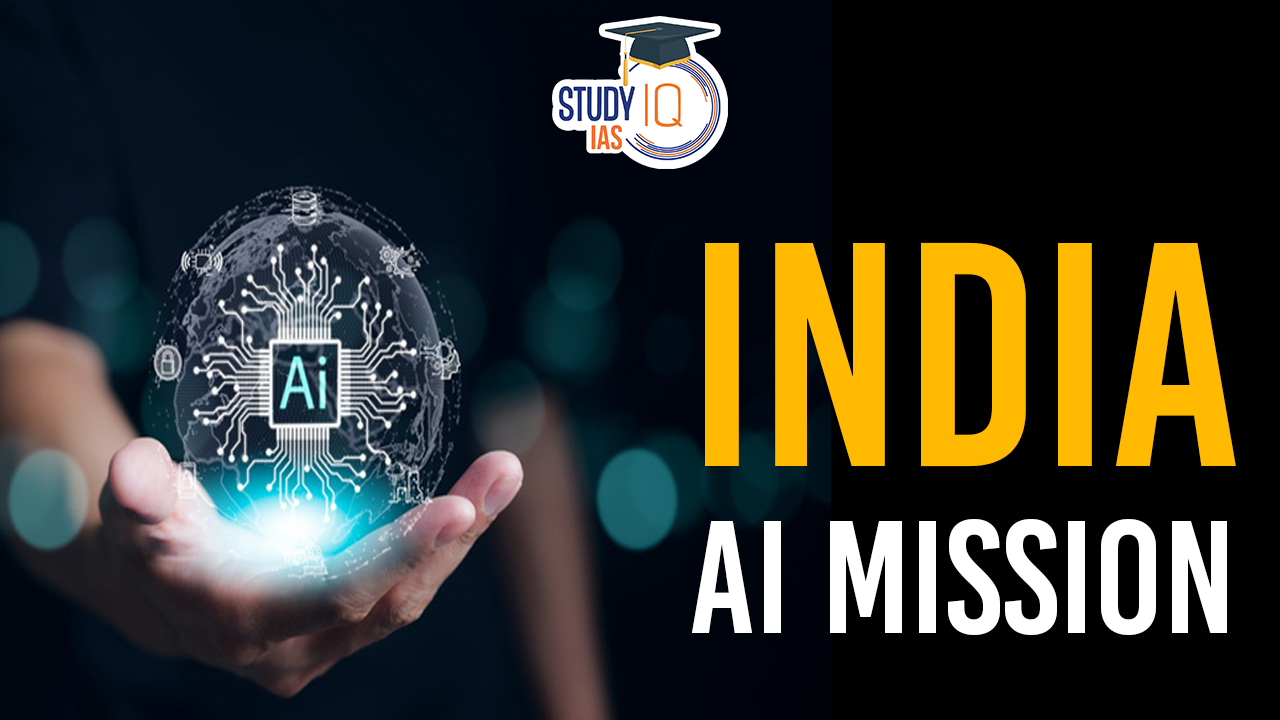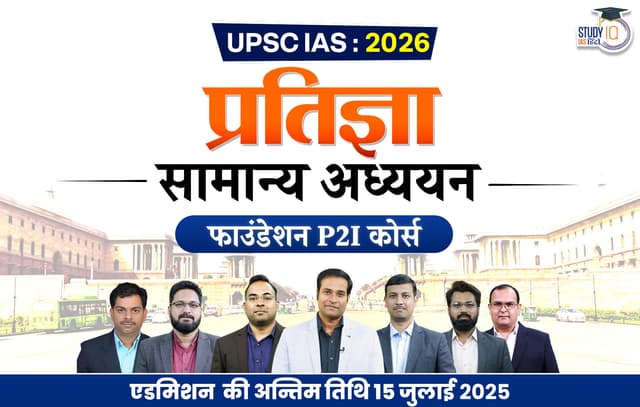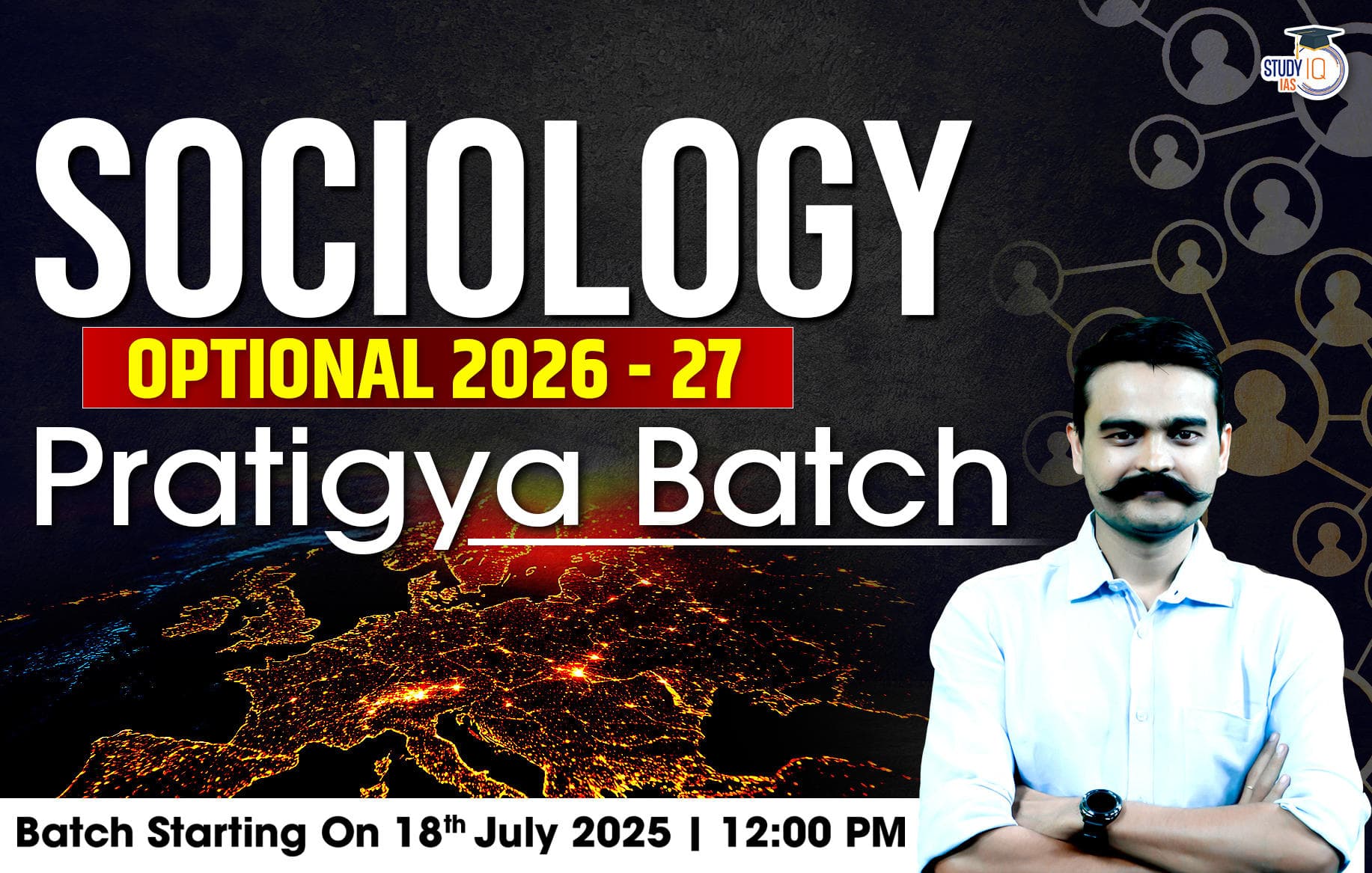Table of Contents
Context: India aspires to global AI leadership but lacks a comprehensive national strategy, risking lagging behind the US, China, and EU advances.
The Government of India has embarked on an ambitious journey to establish the country as a global leader in artificial intelligence (AI) through the IndiaAI Mission. This initiative, which was unveiled by the Prime Minister at the GPAI (Global Partnership on Artificial Intelligence) Summit 2023 in New Delhi, is poised to revolutionise India’s technological landscape, driving innovation, economic growth, and societal benefits.
About India AI Mission
- Launched: 7 March 2024 with a budget of over ₹10,300 crore (~ US$1.2 billion) for 2024–29.
- Purpose & Aim: Propel India to global leadership in AI and democratize AI benefits across all strata.
- Foster technological self-reliance, ethical and responsible AI, and broaden access to AI.

Key Highlights of India AI Mission
By investing in AI research, development, and deployment, India aims to harness the power of AI for inclusive growth and development.
Nodal Ministry and Implementing Agency
The IndiaAI Mission is spearheaded by the Ministry of Electronics and Information Technology (MEiTY). The implementation is entrusted to an independent business division, aptly named ‘IndiaAI’, which operates under the Digital India Corporation (DIC). This ensures that the mission is aligned with the broader goals of Digital India, leveraging the country’s digital infrastructure for AI advancements.
Public-Private Partnership Model
The mission’s infrastructure will be developed through a public-private partnership (PPP) model. To encourage private sector participation and ensure the mission’s success, the government will provide 50% viability gap funding. This approach is designed to create a sustainable and scalable AI ecosystem by pooling resources and expertise from both the public and private sectors.
Significance of India AI Mission
- Global Leadership: Positions India as a serious player in the global AI race, championing inclusive, frugal, and multilingual AI solutions.
- Digital Sovereignty: Reduces dependence on foreign AI infrastructure and models, promotes “Make AI in India, for India.”
- Inclusivity & Equity: Prioritises applications serving all sections of society, including rural, academic, and underserved communities.
- Ethical and Safe AI: Investment in safety frameworks and standards aims to build public trust and responsible AI adoption.
- Ecosystem Building: Encourages collaborations among government, startups, research institutions, and international players.
Achievements of India AI Mission
- AIRAWAT AI Supercomputer: Established one of the world’s top AI supercomputers to boost research and innovation.
- Global AI Skill Leadership: According to Stanford AI Index 2024, India ranks #1 globally in AI skill penetration (score: 2.8), and talent concentration has grown by 263% since 2016.
- Bhashini Platform: Developed multilingual AI tools supporting 22 Indian languages for digital inclusion.
- Centers of Excellence: Launched dedicated AI research centres in healthcare, agriculture, and smart cities
| Global Partnerships & Forums |
|
Issues Associated with India’s AI Mission
- Mission without a Mandate: India’s AI Mission operates as a bureaucrat-led division within a Section 8 company under the Ministry of Electronics and Information Technology, lacking a Cabinet-endorsed national strategy.
- Governance Gap: India faces structural deficits impeding its AI ecosystem that incremental approaches cannot overcome.
- Shallow R&D Base: Universities are underrepresented in global AI rankings. Loss of top-tier AI talent to global hubs.
- Limited pipeline of AI-specialised PhDs.
- Weak collaboration between academia and industry.
- Private Sector Orientation: The IT industry remains oriented toward services.
- Modest research investments relative to international companies.
- Engagement with AI is largely in deployment, downstream of frontier innovation.
- Lacks AI-first national champions and deep-tech industrial ecosystem.
- Venture capital funding skewed towards consumer tech, not foundational research.
- Democratic Deficit (Lack of Parliamentary Involvement): Parliament has remained extraneous to shaping national AI governance.
- Less than 1% of questions in Parliament are on AI.
- No dedicated institutional mechanism for oversight.
- Important debates (strategic autonomy, public data use, energy demands, national security) have received short shrift.
- Undermines India’s international credibility.
| Understanding Graphic Processing Units (GPUs) |
| A significant component of the IndiaAI Mission is the procurement of 1,000 Graphic Processing Units (GPUs). GPUs are specialised computer chips that rapidly execute mathematical operations, particularly those required for rendering graphics and images. However, their utility extends far beyond just graphics; GPUs are integral to creative content creation, video editing, high-performance computing (HPC), and, most importantly, artificial intelligence (AI).
GPUs excel at handling the parallel processing required for AI tasks, such as training deep learning models, making them indispensable in the AI ecosystem. Their inclusion in the IndiaAI Mission underscores the government’s commitment to equipping the country with the necessary hardware to support advanced AI research and development. |
Seven Pillars of the India AI Mission
The IndiaAI Mission is structured around seven key features, each addressing a critical aspect of AI development and deployment:
IndiaAI Compute Capacity
The mission aims to build a scalable AI computing ecosystem that can cater to the increasing demands of India’s burgeoning AI startups and research communities. This involves creating a robust infrastructure that supports high-performance computing and advanced AI applications.
IndiaAI Innovation Centre
Central to the mission is the establishment of an IndiaAI Innovation Centre. This centre will focus on developing and deploying Indigenous Large Multimodal Models (LMMs) and domain-specific models. These models will be tailored to meet the unique needs of various sectors within India, ensuring that AI solutions are relevant and impactful.
IndiaAI Datasets Platform
Access to quality data is a cornerstone of AI innovation. The IndiaAI Datasets Platform will enhance the availability of high-quality, non-personal datasets, which are crucial for training AI models. By providing researchers and developers with the necessary data, the platform will accelerate AI-driven solutions in diverse fields.
IndiaAI Application Development Initiative
To ensure that AI solutions address real-world challenges, the IndiaAI Application Development Initiative will promote the creation of AI applications in critical sectors. These applications will be developed based on problem statements from central and state departments, ensuring that they are aligned with national priorities and needs.
IndiaAI Future Skills
Education and skill development are integral to the mission’s success. The IndiaAI FutureSkills program is designed to increase accessibility to AI education at undergraduate, master’s, and Ph.D. levels. By fostering a new generation of AI talent, the program will ensure that India remains at the forefront of AI innovation.
IndiaAI Startup Financing
Supporting deep-tech AI startups is another crucial aspect of the mission. The IndiaAI Startup Financing initiative will streamline access to funding for startups working on advanced AI projects. This support will help startups scale their operations, bringing innovative AI solutions to market more quickly.
Safe & Trusted AI
The mission also emphasises the importance of responsible AI development. The Safe & Trusted AI initiative will focus on implementing responsible AI projects, including the development of indigenous tools and frameworks to ensure that AI technologies are ethical, transparent, and secure.
Way Forward
- Cabinet-endorsed National AI Strategy: Must be presented to Parliament.
- Sets out a vision, an actionable roadmap, and mechanisms for democratic accountability.
- Empowered Coordinating Authority: Establish an empowered coordinating authority with a whole-of-government mandate.
- Strategic Alignment: Align R&D, industrial policy, and security strategy.
- Frameworks for Engagement and Oversight: Create frameworks for public engagement and parliamentary oversight.
- National Strategic Priority: AI governance must be treated as a national strategic priority, grounded in democratic consensus.


 Patriot Missile System: Features, Capabi...
Patriot Missile System: Features, Capabi...
 Women in STEM Careers, Importance, Oppor...
Women in STEM Careers, Importance, Oppor...
 GLP-1 Drugs: Uses, Genesis and Developme...
GLP-1 Drugs: Uses, Genesis and Developme...





















